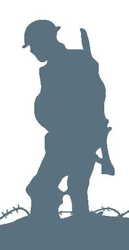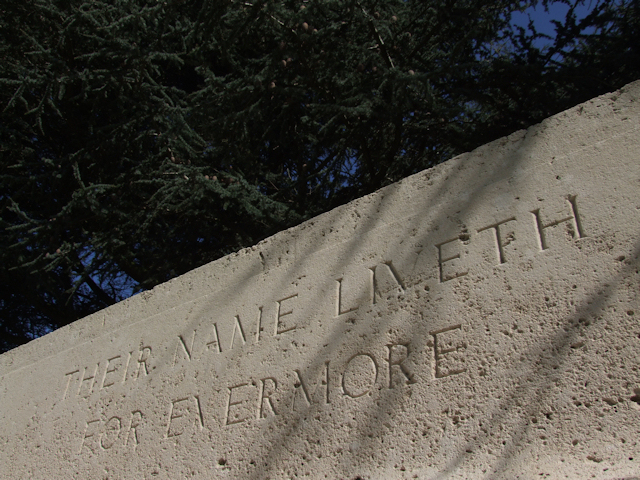Name
Eddie Sopp
Conflict
First World War
Date of Death / Age
11/04/1918
19
Rank, Service Number & Service Details
Private
41805
Hertfordshire Regiment
1st/1st Bn.
Awards: Service Medals/Honour Awards
Not Yet Researched
Cemetery/Memorial: Name/Reference/Country
STE. MARIE CEMETERY, LE HAVRE
Div. 62. III. C. 7.
France
Headstone Inscription
Not Researched
UK & Other Memorials
Hertfordshire Regimental Memorial, All Saints Church, Hertford,
Banstead War Memorial, Banstead, Garton War Memorial
Biography
Eddie Sopp was born in Banstead between December 1898 and January 1899 and was baptised at All Saints on 26th February.
He was the son of Jason and Fanny Sopp (nee Stockwell). Fanny was a Banstead girl, the daughter of James and Tamar Stockwell, and grew up at Perrotts Farm before moving to Mint Cottages, just off Park Road. Jason was a gardener and labourer from Inkpen, Berkshire, and the two of them seem to have met in Croydon, when Jason was living in St. James’s Road and Fanny was also living in the town; they married at St. James’s church, on Croydon Common, on 15th March 1880.
After they married, Jason and Fanny came to Banstead, to live near Fanny’s widowed mother, and made their home in one of the cottages at the far end of Mint Road, near Mint House. Jason worked locally as a jobbing gardener. They had a daughter, Martha Fanny, two months later, on 10th May, and she was baptised at All Saints in June. Sadly, she died within four months and was buried at All Saints.
The Sopps didn’t stay long in Banstead after their daughter’s death and they moved north to Derbyshire, where Jason’s younger brother, George, and his young family were living. Jason and Fanny first lived in Chellaston, then a village but now a suburb of Derby, on the opposite side of Derby to Jason’s brother. A son, Fred, was born in 1882, then a second daughter, Fanny Tamar, arrived on 24th February 1884 and was baptised in Chellaston. A third daughter, Edith Annie, was born in the spring of 1886 but died in infancy later that year. Another daughter, Martha Edith, known as Edith, was born in late 1887.
Following the death of their son, Fred, aged 6, in 1888, the family moved into Derby itself, to 114 Yates Street. Fanny started school, aged 5, at St. James’s Infant School in November 1889 before moving up to St Thomas’s Girls School in March 1890. Jason and Fanny’s fifth daughter, another Martha, Martha Elsie, known as Elsie or Hettie, was born soon afterwards and then the family left Derby in September of that year.
The Sopps came back south to Banstead and returned to Mint Cottages. Their final daughter, Annie was born there in the spring of 1892 and when she was taken to All Saints to be baptised on 24th April of that year, it was with her elder sisters, Edith and Elsie.
The Sopps sadly lost their oldest daughter, Fanny, in 1896 and she was buried at All Saints on 28th September. At about that time, they moved a short distance down Park Road to 1 Apsley Cottages, at the village end of a row of four mid-Victorian cottages by Apsley House, where Eddie, was born in 1898-9.
When Eddie was a toddler, their next-door neighbour, Robert Limmington, fell out with Jason and the two men came to blows. Jason and Limmington had been drinking in the Woolpack on the night of 23rd June. Jason had left sober but Limmington had been “in liquor” having been in the pub for two or three hours. Tempers flared when both men returned home to Apsley Cottages and they fought. Jason sent Fanny for the police, who soon arrived, but not in time to stop Jason being “severely assaulted.” Exactly what happened is a matter of whose story you believe. The two men appeared before the magistrates at the Epsom Petty Sessions a fortnight later. Jason told how Limmington had wanted to fight with him and had smashed a pane of glass by the Sopps’ front door in order to open the bolt and force his way in and had then attacked him. Limmington contested Jason’s version of the story and requested an adjournment to bring witnesses. When the court reconvened a week later, Limmington brought two witnesses and a lawyer and a different story emerged. The two witnesses (Harry Corbett and Harry Smith, both of whom were apparently on friendly terms with Jason) testified that Jason stripped himself and challenged Limmington to a fight. Limmington then went on to say that he and Jason had fought two rounds in the garden but he did not know how Jason’s face got injured. The magistrates decided that there was enough doubt about both versions of the story that both men were to be bound over for six months to keep the peace.
Jason evidently had a breakdown six years later and in July 1906, he was admitted to Brookwood Asylum, in Woking, and was treated until discharged in November. The family moved to Diceland Road shortly afterwards, where they lived at number 3, a semi-detached cottage at the Shrubland Road end. Fanny had gone totally deaf in 1901, at the age of 42, and Geoff Pushman, whose mother opened a shop around the corner in Shrubland Road in 1912, recalled that “she started talking in a whisper and ended in a shout – ‘Nice day today, far BETTER THAN YESTERDAY!’”
Eddie would have attended the school in the village and been a contemporary of several of the youngest men we are commemorating, including Roberts Caselton and Jack Hillman. He probably left school at the standard age of 14, in 1912-13.
Eddie was working as a guard, probably on the railway rather than as a watchman, when he turned 18 and was conscripted at the turn of the year from 1916 to 1917. He was enlisted into the 25th Training Reserve Battalion at Kingston on 8th January and his entry in the Surrey Recruitment Register records that he stood 5ft 9in tall and weighed just under 9 stone.
The Training Reserve, a nationwide organisation that absorbed and replaced the training units run by individual regiments, had been established in the summer of 1916 in order to take responsibility for training the influx of raw recruits after the introduction of conscription. The young conscripts would usually be taken in for training 6-9 months before their 19th birthday, the age at which they would become old enough to serve overseas, and Eddie was called up to begin his training in mid-March.
The 25th Battalion had formerly been the 10th (Reserve) Battalion of the Norfolk Regiment, based at Parkeston, and were part of the 6th Training Brigade. A cadre of trainees, including Eddie, was transferred to the 27th (Young Soldier) Battalion (who were in the same brigade) between 4th-6th June, as part of a reorganisation of 6th Brigade. The 27th had previously been the 10th (Reserve) Battalion of the Bedfordshire Regiment and were based at Dovercourt.
Eddie’s class completed their initial training on 8th August and joined the 252nd (Graduated) Battalion at Colchester. In October, the 252nd Battalion was rebadged as the 52nd and was affiliated to the Bedfordshire Regiment. Eddie and his group stayed on the Home Front until March 1918, when the young men in their class had all reached their 19th birthday.
They sailed from Folkestone to Boulogne on the night of the 18th/19th March and were sent to ‘L’ Infantry Base Depot at Etaples the following day to await posting. They didn’t have to wait long and were posted to the Bedfordshire or Hertfordshire Regiments two days later.
Eddie joined the 1/1st Hertfordshire Regiment. Hertfordshire was a small county and had had no pre-war battalions of the regular Army and only a single Territorial battalion. This battalion was briefly part of the Bedfordshire Regiment following the Haldane Reforms that created the Territorial Force in 1908 but was then redesignated a regiment in its own right the following year, although it continued to have close ties with the Bedfords and was an unofficial Territorial battalion of the Bedfords as they had only one of their own whereas most regiments had two.
The 1st Hertfordshires were working on fatigues at an aerodrome near Moislains, northeast of Peronne, a large town on the bend in the Somme, when Eddie arrived in France. It would probably have been no more than a week before he was sent to join them but on the day that he was posted to the Hertfordshires, 21st March, the Germans attacked.
The transfer of divisions from the collapsed Eastern Front, the introduction of new infantry tactics and an intense, lightning bombardment that smashed the incomplete British defences nearly broke Fifth Army, who were stretched thin, holding a long section of the front line. The Hertfordshires stood to and were called to defend the line. They were forced back as the British retreated, fighting a series of rear-guard actions and losing men heavily as they went. The Battalion were in action for 10 days with little chance to rest and regroup, having to move quickly when threatened with being cut off, making counterattacks when the Germans seemed vulnerable or offering “stubborn” resistance when holding them off. The “remnants” of the Battalion were relieved on 31st March.
They were down to about half strength and in desperate need of reinforcement but the chaos of the retreat meant a delay in Eddie’s group being sent to join them. The remaining Hertfordshires were formed into two companies and joined No.1 Composite Infantry Battalion. 60 men of Eddie’s draft were finally sent to join them at St. Martin-au-Laert, near St. Omer, on 10th April.
Eddie was not with them. By then he was miles away, in No.2 General Hospital, at Le Havre. He was suffering from tonsillitis, no big deal in the Antibiotic Age but there was no penicillin yet in 1918 and would not be for another 10 years. The infection spread from Eddie’s tonsils and he developed blood poisoning (septicaemia). He died in hospital on 11th April 1918, aged 19.
He is buried in Ste. Marie Cemetery, Le Havre. His headstone inscription, chosen by his mother, reads “Loved by All”.
Eddie is commemorated on the Banstead War Memorial, on the Garton Memorial in All Saints churchyard, on the wooden panels in the Memorial Chapel at All Saints and in All Saints’ Book of Men Who Served Oversea in the War 1914-18.
Acknowledgments
James Crouch



